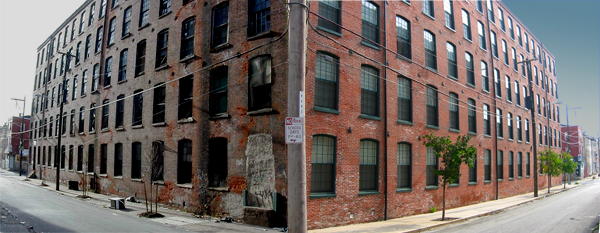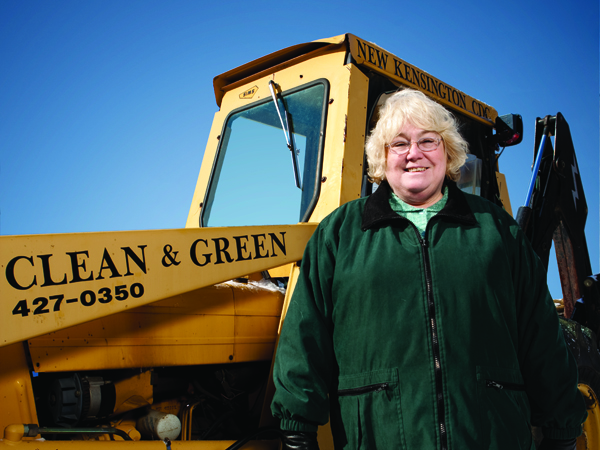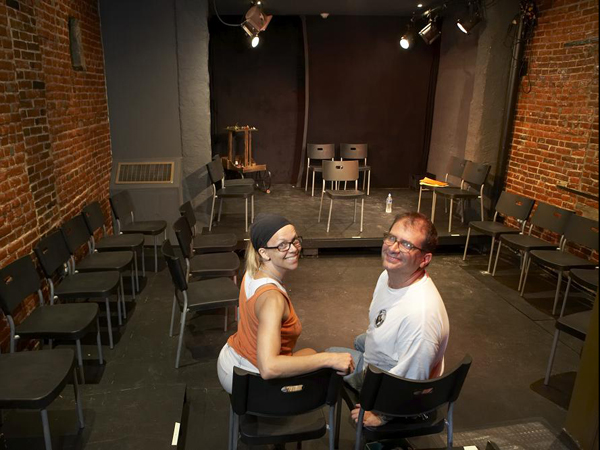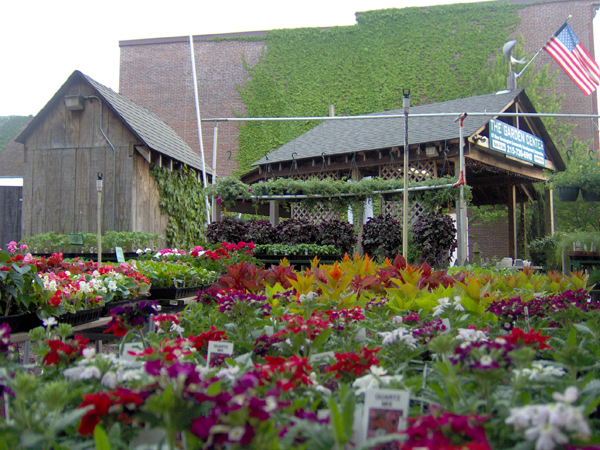 North Philly changes before our eyes
North Philly changes before our eyes
by Will Dean with additional reporting by Dana Henry
When you think about a sustainable city, what does it look like? Whether it’s a futuristic, shiny sci-fi wonderland or a green treehouse-like Ewok village, you probably don’t think of North Philly. With it’s abandoned industrial buildings and bad reputation for drugs and crime, it doesn’t seem like the place where a bright new future full of efficient gadgets and green spaces will emerge. That kind of thinking is a barrier, though, because it’s exactly in those kinds of places that local sustainability can emerge, and on February 4 the Fishtown, East Kensington and Old Richmond sections of North Philly made a step towards becoming the most sustainable section of the city, and perhaps even the country.
Sustainable 19125 (the zip code for the area) is a new program assisted by the New Kensington Community Development Corporation (NKCDC) and the Pennsylvania Horticultural Society (PHS). The details of the program aren’t finalized, but it will probably include traditional sustainable initiatives like more urban gardening, classes on how to install rainwater barrels, the construction of a walkable greenway and incentives to encourage improvements like green roofs and solar water heaters.
New Kensington and PHS are currently leading the effort after receiving grants from the William Penn Foundation of over $500,000, but they plan on getting local groups and community members to take the idea and use it in their own ways.
“It’s about sustainability and investing in the earth,” says Sandy Salzman, executive director of New Kensington. The program will also invest in people with more classes for local students run by Earth Force, a Colorado group that educates school kids on environmental issues.
Although it seems ambitious, Sustainable 19125 is just one more in a series of changes the area has undergone in the last several decades, including a long decline and a recent revitalization shepherded by New Kensington and Salzman.
Salzman is a small, grey-haired woman with a powerful energy behind her twinkling eyes, and she has seen North Philly change.
She grew up in Fishtown, as did her father and her grandfather. Her family’s home, on the 1700 block of Frankford Ave., was part of a row of storefronts with apartments above, and as a kid she played roller skates and hide-and-seek in the empty grocery store below. Today that building is a parking lot.
“The neighborhood had started a descent since the ’50s,” she says. “The block I lived on was demolished… Our houses are rowhomes, so when one house goes, it takes others with it.”
Most of the houses in the area were built using salmon brick, and if one is demolished, the exposed brick—if not taken care of—will quickly degrade and the exposed house will have to be torn down as well. In addition, the I-95 construction was starting, which caused more problems.
“Looking at it all these years later it’s [I-95] still having a negative impact; it’s cutting us off from the river. When it came through, it displaced the area: families, schools, churches.”
She left the area when she got married, as did many other people and much of the industry that once provided jobs. Salzman returned to Fishtown in 1971, but by then the area had “pretty much hit bottom,” she says.
She got involved in community groups in 1979 and in ’95 joined the New Kensington, a nonprofit whose mission was to revitalize the Fishtown, East Kensington and Port Richmond areas.
When Salzman joined, the empty lots in New Kensington’s area looked like landfills. There were over 11,000 vacant lots, and many were filled waist-high with trash that included more than just soda bottles and sandwich wrappers. Construction companies were dumping debris, and people were tossing in full garbage bags, refrigerators, washers and car parts. There were even old boats found in the mix.
Salzman was partnered with the Horticultural Society by the Office of Housing and Community Development to help with a greening and clean-up effort called New Kensington 2000. The idea was to start cleaning up the vacant lots to build community involvement, start improving the look of the area and discourage dumping.
Before this partnership, it was just the scouts and the little old ladies willing to pitch in for an afternoon of clean-up. Then New Kensington bought a tractor and a bulldozer, and that’s when the men joined in. In two years, nearly a third of the lots were cleaned. NK2000, now a neighborhood-wide effort, began planting up to 100 trees in a day, which incidentally relieved the sewage system by absorbing rain water and organizing guerrilla gardening. In 1998, they opened a garden center to provide free gardening education and supplies to neighbors.

The Art of Reusing Space
thanks in part to the efforts of New Kensington and many, many community members, Salzman’s childhood home is slowly changing again. In addition to obvious actions like planting trees and cleaning vacant lots, New Kensington has helped residents gain ownership of vacant lots next to their houses so people will take care of the land, helped residents buy or keep their homes, assisted Greensgrow (an award-winning urban farm) in procuring their land, encouraged a burgeoning artist population and tried to walk the tricky line between revitalization and gentrification.
New Kensington, belying its name, actually serves a wide swath of North Philly. Originally it focused on the 19125 zip code, but in 2006 they added the 19134 area, up to the Frankford creek. Their most obvious areas of influence are right near their offices on Frankford Ave. in Fishtown and East Kensington. Galleries like Bambi and Highwire have opened, along with the Rocket Cat coffeeshop. There are still boarded-up buildings and empty lots, but clean parks, galleries and creative flourishes, such as a fence made of old doors, point to a community of artists that have made the area home.
Artists started to move into Fishtown after getting priced out by the increasingly gentrifying Northern Liberties. That former industrial hub had fallen into abandonment until artists moved in the ’80s and ’90s, then the area got hip and trendy, and pretty soon it became too expensive for artists and former residents to afford it.
In the early part of this decade, artists like Stan Heleva were looking further north, to Fishtown. “We were living in Northern Liberties, but couldn’t afford to buy there,” he says. “But we had heard all about ‘Fishtown, Fishtown’ as a growing artists’ area.” So he and his partner bought a house on Coral St. and started thinking about opening their own theater.
New Kensington saw that artists were moving in and decided to try and manage this new change in their area. “We could either embrace the artist or they come in, gentrification starts and the artist community gets pushed out,” Salzman says. “We decided to embrace them because of the energy they bring and because they tend to do creative things with a neighborhood.”
In 2005, a long-term plan of New Kensington’s was coming to fruition on Coral and Hagert
. Formerly a cotton mill, the largered brick building on the corner had been abandoned for decades until New Kensington bought it in the early ’90s. Inspired by Artspace, an affordable artist housing project in Minneapolis, the Coral Street Arts House opened in 2005, and aside from winning design and historical preservation awards, has housed artists in one- and two-bedroom apartments that go for $300-$700 a month.
“The idea is that we already have a lot of artists here; we wanted to give them the opportunity to get settled and put down roots,” says Laura Semmelroth, coordinator of Coral Street for New Kensington. “We realize artists are often pushed out when the neighborhood gentrifies, even if they are gentrifiers themselves.”
In 2006, 2509 Frankford Ave. was a wreck, a “falling-down” building as Heleva describes it. He and his partner, Michelle Pauls saw an opportunity for theater. At the same time, New Kensington, which owned the building, was looking to attract artists who would stay in the area. So they sold Heleva and Pauls and their nonprofit production company Be Somebody, the property at $20,000 below market value. After 15 months of rehab where they stripped the building “down to its bricks,” Walking Fish Theatre opened in 2007. Pauls and Heleva live upstairs with their young daughter, Astrid.
“Here we are now, wrapping up our second season, and we’re really happy,” says Heleva. “Our business has grown exponentially in between the first and second years.” Their Valentine’s Day Revival Burlesque show sold out and their Family Theatre events, the first Saturday of every month, were popular enough to require more dates next season.

Building Businesses
New Kensington’s area already has dense residential structures and walkable streets that make it easier to both build a strong community and drive less, or not at all. Without strong local businesses, though, residents have to leave the area to work and shop.
Michael’s Decorators, a furniture maker and restorer, moved to Frankford Ave. in 1989. Steve Tonuci, whose father started the company, has seen the business change, literally, thanks to the facade improvement grants New Kensington helped them get. “Before, our front was just blank wood, T-11 [a kind of wood siding],” he says. “We used every cent, and it looks 300 percent better.” Now they have a big burnt sienna awning, plate glass windows to show off their furniture and an appealing mix of yellow and red bricks on the front wall.
“They’re pretty good people down there,” Tonuci says. “They’ve helped us a lot.”
One of the most important functions New Kensington has played over the years is a communications hub for local businesses. New Kensington publishes a directory of local businesses in addition to helping arrange community business events, like the Business Breakfast Meetings that bring local owners together to talk and listen to a speaker about tax issues, how to develop a website and other businesstype things.
When Yards Brewery moved into the old Weisbrod & Hess Brewery on Amber and Hagert in 2001, New Kensington sought them out and started a relationship. Since then, Yards has split into two companies, with the Philadelphia Brewing Company (PBC) keeping the Kensington building, and the relationship has continued. “They contacted us; it was nice they called,” says Nancy Barton, co-owner of PBC. “They gave us lots of information about other local businesses.”
Along with other businesses, PBC helps sponsor the biannual Frankford Ave. Clean-Up by running a big barbecue afterwards for the tired community cleaners. “They [New Kensington] go around and help get a lot of things donated—Fishtown Beverage donates soda, the Thriftway gives rolls,” says Barton.
Barton has also been on the board of New Kensington for the past seven years. Although she is about to step down, she has seen the area change as a result of New Kensington’s focus on attracting artists and helping businesses get access to city and state grants. “The Frankford Ave. Arts Corridor has been a big thing, and it’s really changed the face of Frankford Avenue, so coming into the neighborhood, it’s a much better feeling; there’s a lot of new businesses and a lot of storefronts being rehabbed.”

Strong Communities
Of course, without a strong community of residents, there’s no point to helping businesses.
On a recent February morning, the New Kensington office was bustling with residents looking for help in filling out applications for the Low Income Heating Emergency Assistance Program and Crisis Grants to get service restored. New Kensington functions as an energy center for the area, connecting residents with help paying for energy bills and making improvements on their homes.
It’s also a housing agency. Counselors walk new homeowners through the process of buying a house and help them access any extra loans and grants.
They also try to help the community by assisting people who are about to lose their most precious assets, their homes, to foreclosure.
William Ortiz was facing a bad situation. After making some poor choices and letting his credit card debt get out of control, he followed some bad legal advice to declare bankruptcy and in July ’08 he, his wife and their two kids were about to lose their house. “We would have been homeless,” he says. “My situation wasn’t like a lot of the other ones out there. I was making good money—I just made some bad decisions.”
The company that held his mortgage, Washington Mutual, didn’t want to deal with him, and he and his family were getting prepared for the worst. “I would be on hold for hours,” he says. “They didn’t want to talk to me, and when I talked to other people in my situation, it was the same all around.”
Fortunately, in June, the city had created the Residential Mortgage Foreclosure Diversion Pilot Program in response to the mortgage crisis, forcing lenders to meet with delinquent payees and mediators to try and make some kind of deal. Ortiz was referred to the housing counselors at New Kensington, who had recently extended their service area into his neighborhood of Frankford.
“I talked to the NKCDC and got a package together of all my information, and we sent it to the company,” he says. “It took weeks to get a response, and we had to eventually go to court to get them to talk to us.”
Eventually, thanks to the city’s new law and the help of the housing counselors, Ortiz had his foreclosure date pushed back and then worked out a deal where the interest was lowered and he didn’t have to pay anything out of pocket. Ortiz, who works as a nurse, is grateful, but aware of how close he came to losing everything.
“We’re on firm footing now, but if it wasn’t for this program and the counselors, I would be homeless, god’s honest truth.”
A few blocks from New Kensington’s offices is one of the most impressive sustainable ventures in the city, Greensgrow Farms. On 2501 E. Cumberland St., the organic farm lies on a rehabbed brownfield—formerly abandoned industrial
land—and grows organic produce for the area. They offer a CSA (Community Supported Agriculture) that allows residents to pick up fresh produce from the farm every week during the spring, summer and fall. The farm also uses Integrated Pest Management, which uses natural predators and deterrents to keep out bugs and animals that eat crops, and runs equipment on reused biodiesel.
Several blocks in a different direction is New Kensington’s Garden Center, at 1825 Frankford Ave. The center offers information on urban gardening, plants for sale and free compost and mulch from spring through late fall.
It is precisely those kinds of efforts, along with the creative reuse of our existing structures and reinvesting in our local communities and businesses, that can make our future sustainable. While more efficient lights are important, getting really connected with our local area is what sustainability is all about. Thanks to all the previous efforts and continued community-building, Sustainable 19125 has a chance of making some good changes in the area, which Salzman, though proud of how much has already changed, still sees as a necessity.
“On any given day, you can feel really good about what’s going on, like the day after a clean-up; and on another day, like trash day with trash blowing around, you can think, ‘Oh my god, there’s so much to do.’ ”
But she isn’t leaving—after living her entire life in the area, she’s invested for the long-term. “My sisters all live in the neighborhood, too. It’s amazing we’re all still here, almost hard to believe.”



